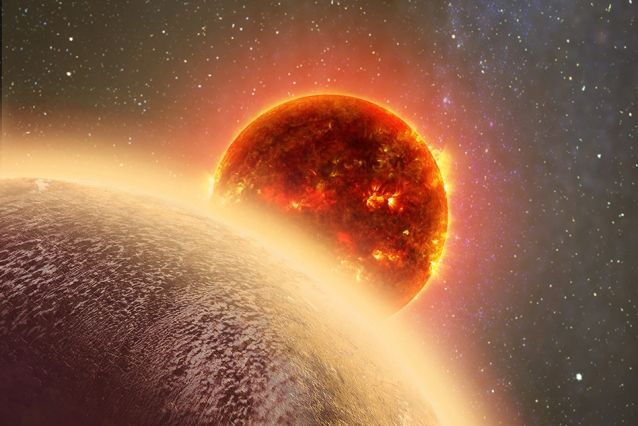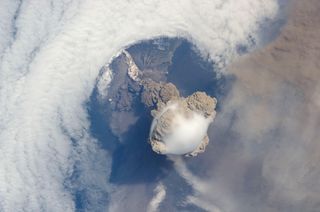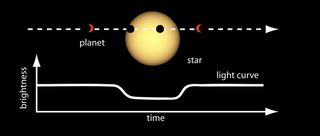Volcanoes Light Up Atmospheres of Small Exoplanets

Geologic activity on a planet is believed to be very important for life, but it can be hard to spot its signs from far away — especially on smaller, rocky planets akin to Earth.
What if there was a large volcanic eruption on such an Earth-like planet — could we spot that? A group of graduate students at the University of Washington's astrobiology program considered this question after it arose during a class discussion about the search for life outside our solar system.
"All life needs energy," said doctoral student Joshua Krissansen-Totton. "At first we thought about plate tectonics. It's not necessary for life, but looking into it, we thought it might be a good indicator of places that are habitable. But it's very hard to spot that, so we looked more closely at volcanism." [Related: The Strangest Alien Planets]
The resulting article, "Transient Sulfate Aerosols as a Signature of Exoplanet Volcanism," was published in the journal Astrobiology in June. The work was funded by the NASA Astrobiology Institute's Virtual Planetary Laboratory.
Subtracting light
A common way of spotting Earth-sized planets is through the transit method. A telescope, such as NASA's Kepler space telescope, monitors a star for a long time looking for a planet to pass in front of it. Spotting small planets is easiest when they orbit dwarf stars because of the smaller ratio between the star's radius and the planet's radius. A larger star has enough light to easily obscure the tiny transit. However, spotting these small planets in this way says nothing necessarily about their atmospheres.
The scenario is arguably easier with very large planets. A spectrometer picks up the spectrum of light coming from the direction of a star and astronomers can look for a change in light signature when a planet passes in front to deduce the chemical composition of the planet's atmosphere. The first such measurements were done in 2002using gas giant HD 209458 (Charbonneau et al., 2002).
Our current technology doesn't allow us to do this with an Earth-sized planet at exoplanet distances, but Krissansen-Totton and his collaborators came up with another solution. When a volcano erupts, it tends to puff out the atmosphere as sulfur leaves the volcano and creates sulfate aerosols in the upper atmosphere through interactions with other molecules. Perhaps it's possible to see an atmosphere expanding and then contracting again on a small planet, even from a fairly large distance.
Get the Space.com Newsletter
Breaking space news, the latest updates on rocket launches, skywatching events and more!

Pinatubo and Sarychev
In this paper, the researchers considered two scenarios. The first was looking at a volcanic eruption about the size of the 1991 Pinatubo eruption. This particular eruption was the second-largest in the 20th Century, following a 1912 eruption in Alaska. They also considered a more common volcanic scenario, such as the relatively small 2009 Sarychev eruption in Russia that caused some disruptions to flights due to an ash cloud.
The researchers tried simulating the capabilities of two forthcoming observatories: NASA's James Webb Space Telescope (to launch in 2018) and the ground-based European Extremely Large Telescope (E-ELT) in Chile, scheduled to light up in 2024.
When the researchers created a model using these scenarios, they discovered that a Sarychev eruption would be very hard to spot on an Earth-sized planet orbiting a Sun-like star about 10 parsecs (32 light-years) away. The larger Pinatubo eruption, however, did create a rapid increase and gradual decrease in the planet's radius that could more easily be spotted with the telescopes.

Recent planetary find
This is all the more exciting, Krissansen-Totton added, with the recent discovery of GJ 1132b. This planet is slightly larger than Earth and hovers so close as to orbit its parent star in a mere 38 hours, making it a real scorcher in terms of temperature. The planet also happens to be relatively near to Earth – just 12 parsecs (39 light-years) away. Krissansen-Totton said there would be limitations in understanding such a planet's atmospheric composition.
"There's a good chance it'll have a thick Venus-like atmosphere," he said. "On Venus, nothing is visible below 90 kilometers because of its cloud layers; explosive eruptions on a Venus-like exoplanet would be obscured by cloud."
Volcanoes are a fairly common feature in the Solar System. In icy form, we have seen eruptions on Saturn's moon Enceladus. There also is evidence of volcanic eruptions (whether in the past or present) in locations such as Venus and even Pluto, the latter of which was seen close-up for the first time this year by NASA's New Horizons spacecraft.
"Many people think hydrothermal settings are crucial in the origin of life," Krissansen-Totton said. "So we're more interested in seeing planets with volcanic activity."
This story was provided by Astrobiology Magazine, a web-based publication sponsored by the NASA astrobiology program. Follow Space.com @Spacedotcom, Facebook and Google+.
Join our Space Forums to keep talking space on the latest missions, night sky and more! And if you have a news tip, correction or comment, let us know at: community@space.com.

Elizabeth Howell (she/her), Ph.D., was a staff writer in the spaceflight channel between 2022 and 2024 specializing in Canadian space news. She was contributing writer for Space.com for 10 years from 2012 to 2024. Elizabeth's reporting includes multiple exclusives with the White House, leading world coverage about a lost-and-found space tomato on the International Space Station, witnessing five human spaceflight launches on two continents, flying parabolic, working inside a spacesuit, and participating in a simulated Mars mission. Her latest book, "Why Am I Taller?" (ECW Press, 2022) is co-written with astronaut Dave Williams.













